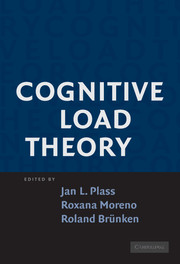Book contents
- Frontmatter
- Contents
- Contributors
- COGNITIVE LOAD THEORY
- Introduction
- PART ONE THEORY
- PART TWO EMPIRICAL EVIDENCE
- PART THREE DISCUSSION
- 9 Measuring Cognitive Load
- 10 From Neo-Behaviorism to Neuroscience: Perspectives on the Origins and Future Contributions of Cognitive Load Research
- 11 Cognitive Load in Learning with Multiple Representations
- 12 Current Issues and Open Questions in Cognitive Load Research
- Index
- References
10 - From Neo-Behaviorism to Neuroscience: Perspectives on the Origins and Future Contributions of Cognitive Load Research
Published online by Cambridge University Press: 05 June 2012
- Frontmatter
- Contents
- Contributors
- COGNITIVE LOAD THEORY
- Introduction
- PART ONE THEORY
- PART TWO EMPIRICAL EVIDENCE
- PART THREE DISCUSSION
- 9 Measuring Cognitive Load
- 10 From Neo-Behaviorism to Neuroscience: Perspectives on the Origins and Future Contributions of Cognitive Load Research
- 11 Cognitive Load in Learning with Multiple Representations
- 12 Current Issues and Open Questions in Cognitive Load Research
- Index
- References
Summary
HISTORICAL PERSPECTIVES ON COGNITIVE LOAD RESEARCH AND THEORY
European and American psychology may have developed in a way that prevented or delayed the development of Cognitive Load Theory (CLT) until George Miller's (1956) classic paper on working memory capacity appeared a half century ago. At the beginning of the twentieth century and fifty years before Miller's paper kick-started the field of cognitive science, Charles Hubbard Judd (1908) lost an important argument with Edward Thorndike (1903) about the role of mental effort in the transfer of learning. The loss helped to sidetrack psychology into emphasizing behaviorism over cognitive processing. Judd, an American who was Wilhelm Wundt's student in Leipzig at the end of the nineteenth century, hypothesized that internal cognitive processes and external instructional strategies supported the mental work necessary to transfer knowledge between different problem contexts and settings. Judd had learned from Wundt to emphasize a version of scientific psychology that favored the study of consciousness, problem solving, thinking, and sensations. Judd's (1908) famous bow and arrow experiment demonstrated that effortful cognitive processes could support the generalization of a principle about the diffractive properties of water and so allow people to adjust their aim with the bow to hit an underwater target that appeared to be somewhere else. Thorndike (1903) focused his research on animal maze learning and proposed an “identical elements” transfer theory, arguing that it was positive reinforcement that led to learning and transfer – and not cognitive processing.
- Type
- Chapter
- Information
- Cognitive Load Theory , pp. 203 - 228Publisher: Cambridge University PressPrint publication year: 2010
References
- 8
- Cited by



